Jump Ahead To:
MINN KOTA TALON: INTRO
Anchoring a fishing kayak can be a bit of a challenge. Swift moving currents, high winds, wakes from other boats, all of these factors can combine to move your kayak out of its desired location – unless its properly anchored, of course! By now we know that Minn Kota is one of the premier makers of kayak trolling motors (check out our Kayak Trolling Motor Ultimate Guide to learn more – we’ve even ranked The 5 Best Kayak Trolling Motors), but did you know that they manufacturer kayak anchors as well?
The Minn Kota Talon is one of the best kayak anchors on the market – let’s find out why!

Minn Kota Talon: Guide
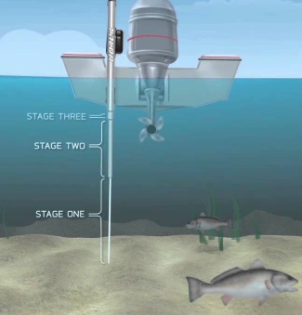
First, as an Amazon Associate, I earn from qualifying purchases.
This KFC article contains all of the important details about the Minn Kota Talon – the best fixed kayak anchor on the market! To make sure we capture all of the important information in an easy to follow style, we’ve organized this post into a number of different categories. We start by going over some of the basics about kayak anchors in general – what they are, how they are used, what kinds of different styles there are.
After that, we go into a short “how to” checklist that will serve as your handy guide for learning how to install and use the Minn Kota Talon on your fishing kayak. After that, we’ve included a list of some of the important features included with this awesome piece of kayak fishing gear to show you why it is truly the best of the best!
We have also included a link to Minn Kota’s product page so you can learn first hand about some of the other features of the Talon and how it has been specifically designed to keep your kayak safely located in your desired spot. Finally, we have included a short story detailing our own experience using the Minn Kota Talon in our own kayak fishing outings. It is our hope that you can avoid some of the mistakes we made, and maybe learn a thing or two from some of the things we did right. Let’s dive in!
Minn Kota Talon: The Basics

Please note: This post contains affiliate links. An affiliate link means that we may earn advertising/referral fees if you make a purchase through our links.
Shortcut to the Minn Kota Talon Review
Above we have included an image of the Minn Kota Talon. Of course, this is what the kayak anchor looks like when it is not deployed. When extended to full length, the Talon stretches to 12 feet! You’ve probably noticed that the Talon is unlike many of the other kinds of kayak anchors on the market.
Many fishing kayak anchors are built of the more traditional style – a long rope of chain connected on one end to a heavy anchor with two or three prongs, and on the other end to an attachment point that is tied to the kayak’s cleat (learn more about optimal cleat placement). These types of more traditional kayak anchors can be very effective so long as you’ve learned how to use them properly!
The Talon style of kayak anchor is different. Think of it as a long pole that deploys from the kayak’s hull, dropping into and securing itself to the bottom of the water. The kayak will still turn and move with the wind and current, but it will revolve around the elongated anchor pole, rather than floating to maximum distance permitted by the chain featured by the previous type of anchor design. This keeps the fishing kayak as centered as possible above your desired fishing hole!
How to Use Properly
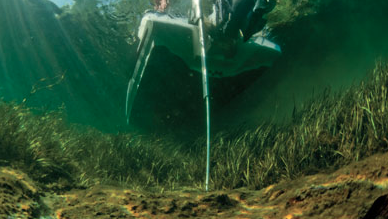
Buying a Minn Kota Talon and learning how to use it properly are two different things! After all, improper use of this kayak fishing accessory will actually result in a worse outcome than not using one at all – plus, you could be out a significant amount of money in terms of damage to your product, your kayak or even someone else’s property!
The short checklist below will take you through some of the most important steps to follow when installing and using the Minn Kota Talon. In our experience, the proper use of the Talon results in keeping the kayak better centered and for longer periods of time. This is when compared against a traditional kayak anchor and, needless to say, when compared to not using a kayak anchor at all!

- For some, this step is obvious. For others, not so much. It is absolutely necessary that you read the owner’s manual that comes along with the Minn Kota Talon.
- After familiarizing yourself with its contents, you’ll probably be excited to try it out for yourself!
- Locate the included mounting bracket and affix it directly to the transom of the fishing kayak. Remember, “transom” is just a fancy word for a flat surface!
- If your kayak does not have a transom, then you’ll need to use an adapter plate (also offered by Minn Kota).
- You’ll want 6 inches of horizontal distance between the mounting plate and the center of the Talon’s tube. This is very important because it allows for the anchor to deploy straight down without obstruction!
- Also, in terms of distance, you’ll want at least 4 inches of space between the bottom of your kayak and the bottom of the Talon’s tube (any lower and the bottom of the Talon will splash and spray while you are traveling along the water).
- Connect the Talon to the mounting bracket using the included bolts. Make sure to adjust to set your angle so that the Talon sits directly perpendicular to the water!
- Now is the time to connect and route the power cable and deployment notification alarm.
- You can now connect to your battery – just make sure everything is in the “off” position prior to making this connection!
- Once turned “on” check the Talon’s panel display lights to ensure that everything is in working order!
- Please note that the above steps are included in much greater detail in the Talon’s owner’s manual (which we found to be very user friendly). The owner’s manual has nice colored pictures and allowed us to get everything up and running in just about 60 minutes. Not bad!
Minn Kota Talon: Important Features
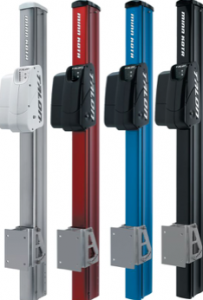
Like we mentioned before, there are a number of different types of kayak anchor on the market – and that’s good news for kayak fishermen! Not only does the increased variety provide a greater number of choices, it also helps bring the cost of these awesome kayak accessories down to a more manageable level! There are also several different kinds of pole anchors (like the Talon) on the market, though the quality of the anchors does vary to a pretty significant extent.
If you decide to move forward with a pole anchor, you’ll want to be certain that it contains the following top 3 features. Without each of these three features, you’ll be missing some of the components that actually make the pole anchor an attractive alternative to a traditional kayak anchor. Let’s take a look at each of the three features individually so we can learn more about them and discover why they are so important for kayak fishing!

Adequate Length. The length of a pole anchor like the Minn Kota Talon is of exceptional importance. We suggest that our readers stick with pole anchors that are at least 10 feet in length. It is important that your anchor pole is long enough to reach the bottom of the shallow water in which you are fishing.
That said, we also caution against a pole anchor that is in excess of 16 feet. Why? Other types of anchors are more appropriate in this situation, and a pole saw of a length in excess of 16 feet is more prone to pending, snapping or other kind of failure. Take a look at an example of the Minn Kota Talon when fully deployed (image below). A pretty impressive range!
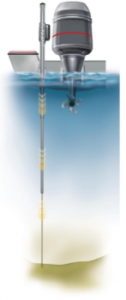
Pivot Design; Quality Spike. These two components are absolutely critical to your kayak anchor pole. Your kayak anchor needs to have a pivoting design that allows the kayak to twist and turn with the current and winds, all while staying safely located above the desired fishing location.
If you have an anchor pole, but it hasn’t been designed to pivot, your anchor (or the kayak itself) is at very real risk of failing or otherwise sustaining significant damage. You’ve heard the expression “bend but don’t break” right? Well, that is exactly what the pivot system on a pole anchor is designed to do. Only here, it is not “bending”, rather it is “pivoting”. Take a look at the depiction of how a pivot pole works (image below):
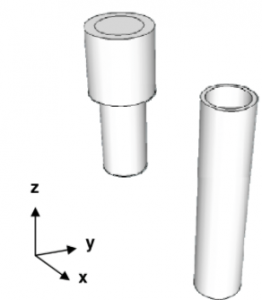
Of equal importance is the pole anchor’s “spike”. What is a spike? This is the piece located at the very end of the anchor. It is made of metal and is usually between 1/4 of an inch to 1 full inch in diameter. Its purpose is to penetrate the bottom of the water (whether mud, loose gravel, rock, or other water bottom) and sink sufficiently far into the water’s bottom to provide an anchor point for the pole anchor.
As you might have guessed, if the anchor spike fails (or isn’t of enough quality to penetrate the water’s bottom in the first place) you aren’t going to be able to secure your kayak’s position. Make sure your anchor’s spike is made of metal and is strong (yet flexible) enough to ensure a sturdy connection to the water’s bottom!
Variety of Anchoring Modes. Every kayak fisherman knows that no two days on the water are the exact same. Simply put, you’ll be dealing with different winds, currents and conditions from other watercraft each time you are out on the water. You’ll want to make sure that your pole anchor comes with a number of settings that will allow you to adapt the anchor to the specific kids of conditions that you will be encountering.
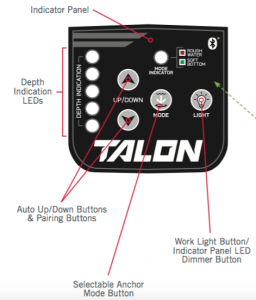
The best pole anchors for kayaks will have several settings. The first is the generic mode (usually called “Auto”) which is good for addressing the typical water bottom’s you might encounter. The second is a form of “Soft Bottom” mode which is perfect for use in very soft muddy water bottoms (those which you might encounter in lakes created by the damming of rivers).
The third is a type of “Rough Water” mode which will serve you well when the currents are strong, the winds are high or you are contending with a high number of wakes from other watercraft. If your pole anchor only has one setting, you and your kayak may very well be overmatched. Multiple settings, however, will allow for you to adjust to the conditions at hand!
Buy the Minn Kota Talon
(Commissions Earned)
Like we stated earlier in this article, the quality of kayak pole anchors is going up – and thats great new for the kayak fishing community! That said, there has long been, and there continues to be, one manufacturer and model that is the best of the best. We are referring, of course, to the Minn Kota Talon (pictured above). The Minn Kota Talon has all of the features necessary to make it an ideal pole anchor, and one that is particularly well suited for kayak fishing!
The Minn Kota Talon is 12 feet in length, which is more than enough size to safely anchor your kayak to shallow water bottoms. Despite its 12 feet in length, it deploys roughly twice and face, and asserts roughly twice as much force, than does its nearest competitor.
Quick deployment is critical when the water gets rough, or when you want to stake your claim before your rival fisherman are able to make a claim of their own!
Most users operate the Minn Kota Talon by way of the included touch panel, though the unit comes with a wireless remote so that you don’t have to stretch to an uncomfortable position to manage your controls. This is also handy when you are standing while casting, as you’ll likely be a located nearer to the front or middle of the kayak, while the Talon will be located near the back.
The Talon also has Auto Drive, Soft Bottom and Rough Water modes, making it a very versatile pole anchor and perfectly positioning it for the variety of conditions sure to be encountered while kayak fishing!
My Experience

I’ve historically used one of the more “traditional” kayak anchors but have slowly become frustrated with their inability to keep my kayak safely atop my desired location. Sure, they were sturdy enough to ensure that I didn’t drift too far, but their range would allow me to travel 20 or so feet away from my intended location. This was not ideal!
The pivoting design of the Minn Kota Talon proved to be the answer to my anchoring problems. The pivot still allowed for my kayak to move and sway with the winds and current, but I did not deviate so far from my desired location so as to require an additional cast. This has resulted in more time with my line in the water. It has also resulted in my line staying in the part of the water where I wanted it to be in the first place!
One additional comment: I did need to buy an adapter plate in order to be able to safely mount the Minn Kota Talon to my kayak. I have been pleased with the design of the adapter plate (and the Talon itself, of course) and found that I was able to make the installation in just about an hour. This piece of kayak fishing gear is one that will make an immediate positive impact upon your kayak fishing outings. Anytime we see a product that has that potential, we are quick to recommend that you consider buying one for yourself!
MINN KOTA TALON: CONCLUSION
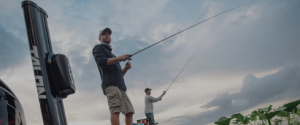
I hope this post has proven to serve as a helpful resource for learning about the Minn Kota Talon – one of our all-time favorite pieces of kayak fishing gear! If you’ve made it to this point in our guide and find that you still have questions about the Minn Kota Talon – whether it is right for you? How to install it? Which type of water is it best suited for use in? Or any other question, we’d like to encourage you to post in the Comments section below.
We read and respond to every comment. If we don’t know the answer, we are certain one of the thousands of other KFC readers will be able to jump in and help you out!
Oh, by the way, if you are on this page, then you are looking for convenience! Take a look at another super convenient piece of kayak fishing gear and see if the Best Kayak Trolley could be right for you! Also, if you’re interested in adding even more of the “high tech” gear to your kayak, check out our buying guide on How to Buy a Kayak Trolling Motor!
Have you ever wanted to take your kayak fishing skills to the next level by competing in a tournament? Take a look here!
Comments
Do you use a kayak anchor when kayak fishing? Do you use the traditional model? Have you ever tried a pole anchor like the Minn Kota Talon? What has been your experience? Did you find that one style of kayak anchor performed better than the other? Or did you discover that each type of style had its own benefits and drawbacks?
Make sure to post below! Our Comments board serves as the internet’s gathering place for kayak fishing enthusiasts all across the world! We love to hear from you! See you on the water!
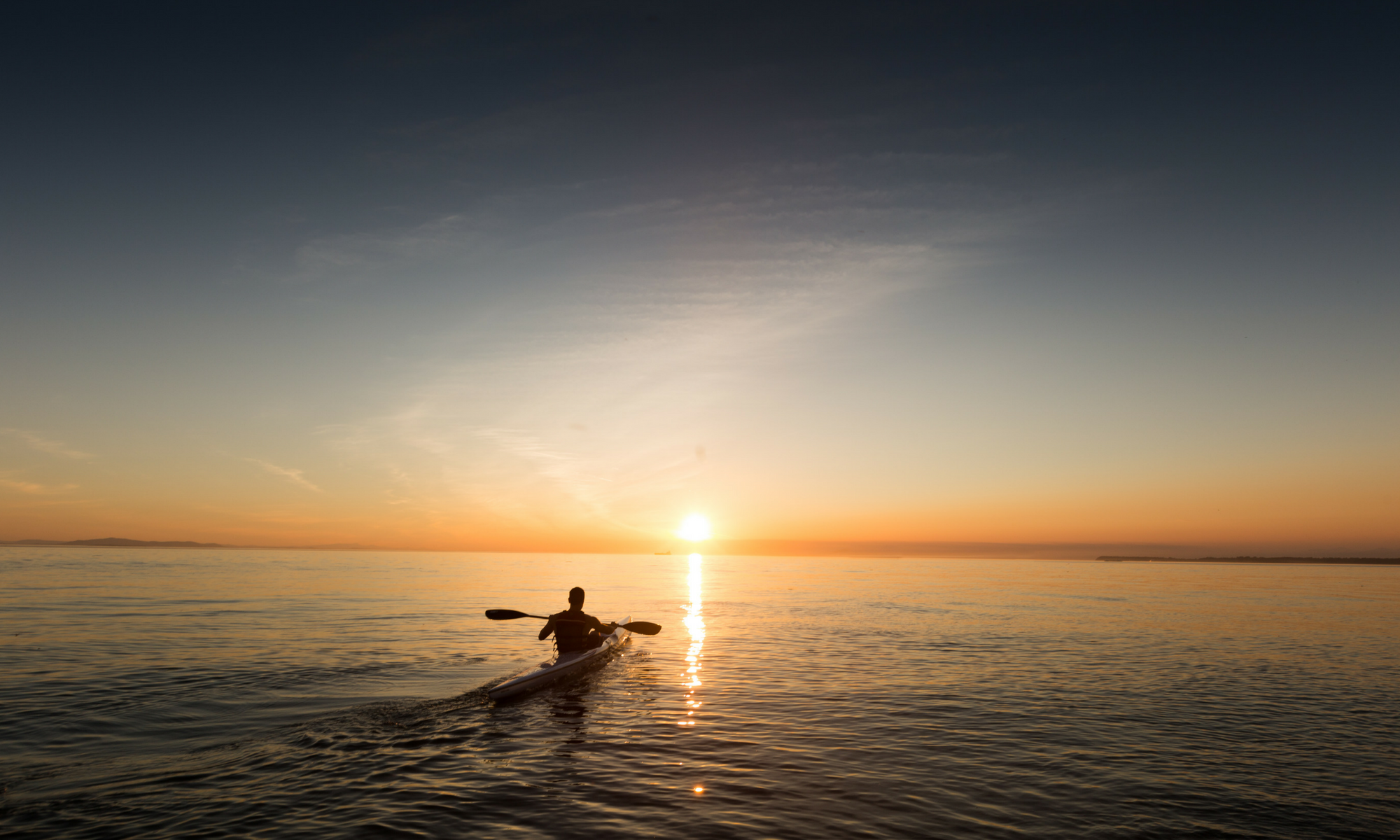
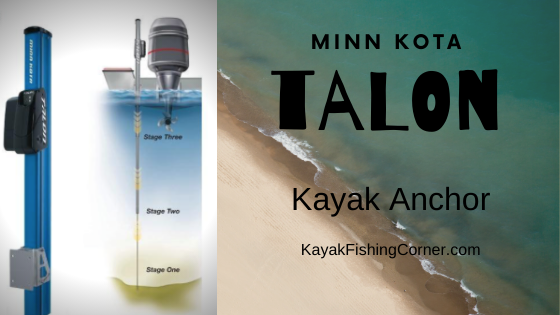

How do I buy the bracket for mounting on a hobbie kayak?
Hi James –
We’ve had good luck on Amazon. They sell a wide variety of brackets for the Minn Kota Talon. You’ll probably want a “Talon Tilt Bracket”, a “Talon Sandwich Adaptor Bracket” or a “Talon Bracket Jackplate” depending on what model of Hobie you are fishing with.
Let us know how it works!
DS